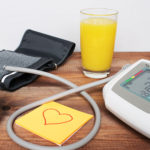Heart Healthy Benefits
Florida Orange Juice has many heart-healthy qualities:

- no added sugar
- no fat or cholesterol
- sodium free
- contains vitamins & minerals that are part of a heart healthy diet
- 100% orange juice has been shown in clinical studies to:
100% orange juice has been shown in clinical studies to:

- reduce total cholesterol1-5
- reduce “bad” cholesterol (LDL)1-5
- reduce blood pressure4,6,7
- reduce or not affect triglyceride levels1-4
- increase “good” cholesterol (HDL)1,8,9
Nutrition Research Corner for Health Professionals
Vitamins and minerals found in 100% orange juice can be part of a heart healthy diet:
Vitamin C is a dietary antioxidant10 has been shown to reduce monocyte adhesion to vascular tissue, improve nitric oxide production and vasodilation, all factors which support cardiovascular health.11 Orange juice is an excellent source of vitamin C providing more than 100% of the recommended Daily Value (DV) in one cup (250ml).*
Potassium is an electrolyte that helps maintain fluid balance which affects blood pressure. It is also needed for heart function and nerve transmission. A normal blood pressure and heart beat depend on potassium. Your muscles and kidneys need potassium to work properly too. A healthy diet containing foods high in potassium and low in sodium may reduce the risk of high blood pressure, a risk factor for stroke and heart disease.10 A diet rich in a variety of vegetables and fruit may help reduce the risk of heart disease. 10 People suffering from kidney disease should consult their doctor on how much potassium is right for their diet. 100% orange juice provides 10% of the Daily Value of potassium in one 8-ounce serving.*
Folate and Vitamin B6 may help regulate homocysteine – some studies suggest that folate and vitamin B6 may help protect against heart disease by lowering homocysteine levels in the blood.12 Homocysteine is an amino acid and high blood levels are believed to cause damage to the arteries and increase the risk of blood clots. One 8-ounce glass of orange juice contains 15% Daily Value of folate and 8% Daily Value of vitamin B6.*
Citrus and 100% Orange Juice Can Be Part of a Heart Healthy Diet
Epidemiological data suggest consuming fruits and vegetables, including citrus and citrus juices, may have a positive impact on the cardiovascular system as they have been associated with reduced risks of cardiovascular disease and stroke.13-18 A meta-analysis published in the journal Advances in Nutrition found 100% citrus juice consumption may be related to a lower risk of ischemic stroke.19
The interest in flavonoids and heart health is growing. In several prospective cohort studies, higher intakes of the flavonoids found in citrus, hesperidin and/or naringenin, were associated with:
- 52% reduction in cardiovascular events8
- 41% reduction in all-cause mortality20
- A decreased cardiovascular risk score, and lower changes in risk score over time in older men (45-64 years)20
- 22% decreased risk of ischemic stroke in men21
- 19% decreased risk of ischemic stroke in women22
- 22% lower risk of coronary heart disease in post-menopausal women23
Blood Lipids
Based on NHANES 2003-2006 data, children and adolescents who were orange juice consumers had significantly lower serum LDL concentrations compared to non-consumers.25 Observational studies also report associations between adults who consume orange juice and significantly lower total and LDL cholesterol levels, with males having a 23 percent reduced risk for having low HDL concentrations, compared to non-consumers.26
Several clinical studies report significant decreases in total cholesterol and LDL cholesterol in adults who consumed orange juice.1-5 Significant increases in HDL have also been reported,1,8 including in participants who were hyperlipidemic.8 Notably, increases in HDL were observed in adults consuming 500mL of orange juice with a high-fat/carb meal compared to when the meal was consumed with water or a glucose drink. Most studies show no effect on triglycerides with orange juice consumption,1-3,27 although reduced triglycerides in inactive men have been reported.4
Blood Pressure
Adults consuming 500mL of orange juice daily for four weeks had significant decreases in systolic (sBP) and diastolic blood pressure (dBP).6 As part of a hypocaloric diet, obese children (9 to 13 years old) consuming 250mL mandarin juice twice a day for four weeks had decreased sBP and dBP which was not observed in the control group on the same diet.28 Other clinical studies report reduced diastolic blood pressure (dBP) in inactive and overweight men who consumed orange juice.4,7 Furthermore, a meta-analysis of randomized controlled trials concluded that fruit juice intake had a borderline significant effect on reducing dBP.29
Endothelial Function and Inflammation
Research supports 100% orange juice and the plant compound hesperidin, found almost exclusively in citrus,24 on reduced inflammation , improved blood flow, and other benefits of cardiovascular health.
In a clinical trial of overweight older men (51 to 63 years old), the consumption of 500ml of OJ or a hesperidin drink increased microvascular reactivity (skin blood flow) after six hours compared to the control. Interestingly, orange juice was more potent than hesperidin in acute measures of blood flow suggesting synergistic effects of the compounds in orange juice.7
In a randomized controlled cross-over study in overweight adults, orange juice, high-flavanone orange juice, and whole orange (blended and homogenized into a juice) attenuated the adverse effects of a high-fat meal on endothelial function (smaller reduction in blood flow) and sustained plasma nitrite levels (endogenous marker of nitric oxide production) compared to the control drink.30
Orange juice intake had beneficial impacts on various markers of oxidative stress and inflammation,31 and orange juice and hesperidin increased the expression of several genes associated with anti-inflammatory and antiatherogenic activities.32 Notably, consumption of orange juice helped attenuate the inflammatory response of a high-fat meal.33
Furthermore, orange juice consumption decreased pro-coagulant activity of whole blood, thus lowering the ability for blood to clot, in healthy young adults.34
*Values based on a 2000 calorie diet. Nutrient values may vary based on manufacturer, brand and product types.
References
- Aptekmann et al. Maturitas. 2010;67:343-347.
- Cesar et al. Nutr Res. 2010;30:689-694.
- Cesar et al. Rev Nutr. 2010;23:779-789.
- Basile et al. Proc Fla State Hort Soc. 2010;123:228-233.
- Dourado et al. Food Nutr Res. 2015;59:28147.
- Asgary et al. ARYA Atheroscler. 2013;9:98-101.
- Morand et al. Am J Clin Nutr. 2011;93:73–80
- Kurowska et al. Am J Clin Nutr. 2000;72:1095-1100.
- Chaves et al. J Proteome Res. 2017;16(11):4086-4092.
- Canadian Food Inspection Agency (2018, May 11): Nutrient Function Claims. Retrieved June 12, 2019 from http://www.inspection.gc.ca/food/general-food-requirements-and-guidance/labelling/for-industry/health-claims/eng/1392834838383/1392834887794?chap=9
- Vitamin C. Health Professionals Fact Sheet. Office of Dietary Supplements. National Institutes of Health. https://ods.od.nih.gov/factsheets/VitaminC-HealthProfessional/
- Institute of Medicine. Dietary Reference Intakes for Thiamin, Riboflavin, Niacin, Vitamin B6, Folate, Vitamin B12, Pantothenic Acid, Biotin, and Choline. Washington, DC: The National Academies Press. 1998.
- Lai et al. Eur J Epidemiol. 2015;30(9) :1035-1048.
- Yamada et al. J Epidemiol. 2011;21(3)169-175.
- Goetz et al. J Nutr. 2016 ;146(11) :2233-2243.
- Joshipura et al. JAMA. 1999;282:1233-1239.
- Mizrahi et al. Br J Nutr. 2009;102:1075-1083.
- Aune et al. Int J Epidemiol. 2017 ;46(3) :1029-1056.
- Auerbach et al. Adv Nutr. 2018;9(2):78-85.
- Ponzo et al. J Transl Med. 2015;13(1):218.
- Cassidy et al. Am j Clin Nutr. 2016:104(3) :587-594.
- Cassidy et al. J Cerebral Circul. 2012 ;43(4) :946-951.
- Mink et al. Am J Clin Nutr. 2007;85(3):895-909.
- Bhagwat S, Haytowitz D. USDA Database for the Flavonoid Content of Selected Foods Release 3.2. In. Beltsville, MD: Unites States Department of Agriculture; 2015.
- O’Neil et al. Nutrition Research. 2011;31:673-682.
- O’Neil et al. Nutr J. 2012;11:107.
- Moreira et al. Food Res International. 2018;107:346-352.
- Codoner-Franch et al. Acta Paediatr. 2010;99(12):1841-1846.
- Liu et al. PLoS ONE. 2013;8:e61420.
- Rendeiro et al. Br J Nutr. 2017;116(12):1999-2010.
- Constans et al. Clin Nutr. 2015;34(6):1093-1100.
- Milenkovic et al. PLoS One. 2011; 6:e26669.
- Cerletti et al. Thromb Res. 2015;135:255-259.
- Napoleone et al. Thromb Res. 2013;132(2):288-292.
